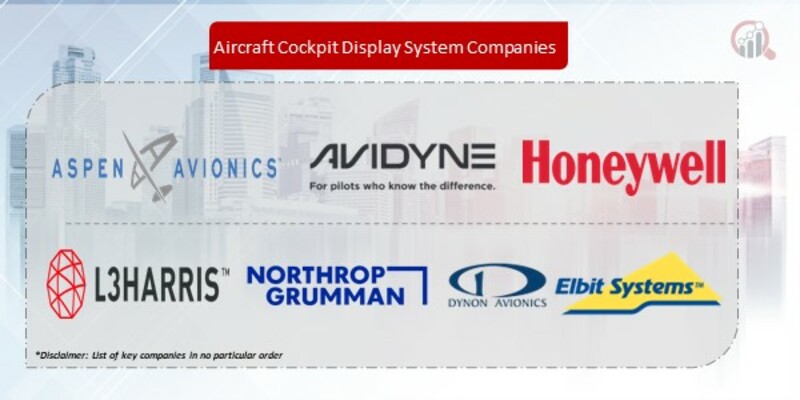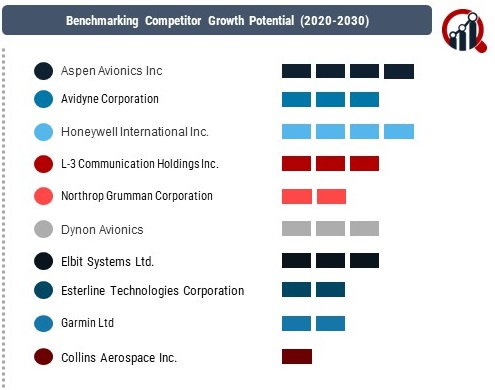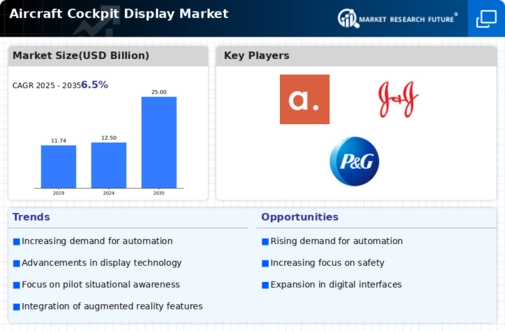Top Industry Leaders in the Aircraft Cockpit Display System Market

Companies Covered
Aspen Avionics Inc. (US)
Avidyne Corporation (US)
Honeywell International Inc. (US)
L-3 Communication Holdings Inc. (US)
Northrop Grumman Corporation (US)
Dynon Avionics (US)
Elbit Systems Ltd. (Israel)
Esterline Technologies Corporation (US)
Garmin Ltd (US)
Collins Aerospace Inc. (US)
Thales Group (France)
Universal Avionics Display Type Corporation (US).
Strategies Adopted
Market share analysis in the Aircraft Cockpit Display System Market is significantly influenced by factors such as the development of advanced display technologies, successful integrations with modern avionics suites, and the ability to provide comprehensive cockpit solutions for various aircraft platforms. Pricing strategies, coupled with the performance and reliability of cockpit display systems, are crucial for these companies to secure contracts and sustain a competitive edge in the market.
Emerging Companies
As the aviation industry continues to evolve, new and emerging companies are entering the competitive landscape with innovative cockpit display solutions. Companies such as Aspen Avionics, Inc., Avidyne Corporation, Innova Avionics, Inc., Genesys Aerosystems, and Innovative Solutions & Support, Inc., often specialize in specific aspects of cockpit display technology, such as glass cockpit upgrades, touch screen displays, and integrated avionics solutions. The agility of these emerging players allows them to address evolving aviation requirements, challenging the dominance of established market players.
Industry news within the Aircraft Cockpit Display System Market often highlights successful cockpit display system installations, collaborations between avionics suppliers and aircraft manufacturers, and advancements in display technologies for various aircraft types. Companies regularly announce new contract awards, partnerships, and advancements in their cockpit display capabilities to showcase the reliability and efficiency of their solutions. Regulatory updates related to avionics standards, safety certifications, and international collaborations in aviation technology also impact the competitive dynamics of the market, prompting companies to align their offerings with evolving requirements.
Current trends in company investments within the Aircraft Cockpit Display System Market reflect a notable focus on increasing display size and resolution, enhancing touch screen functionalities, and the integration of advanced features such as synthetic vision systems and augmented reality displays. Companies allocate resources to develop cockpit display solutions that improve situational awareness, reduce pilot workload, and ensure the compatibility of their systems with modern avionics architectures. Strategic partnerships, participation in industry conferences, and collaboration with aircraft manufacturers and avionics suppliers are common trends among key players to stay abreast of technological advancements and maintain competitiveness.
The overall competitive scenario in the Aircraft Cockpit Display System Market remains dynamic, with companies navigating evolving aviation requirements, technological advancements, and international aviation standards. Established players face the challenge of continuously innovating to meet the changing needs of aircraft operators and ensuring their cockpit display systems remain at the forefront of technology. The competition is expected to intensify as emerging companies secure contracts, introducing novel display technologies and challenging the market share of established cockpit display solution providers. In this environment, adaptability, responsiveness to aviation requirements, and a commitment to technological excellence will be crucial for companies to maintain and enhance their competitive positions in the Aircraft Cockpit Display System Market.
Recent News
Secured a multi-million dollar contract to supply its next-generation Enhanced Flight Vision System (EFVS) to a major airline, enhancing pilots' situational awareness in low-visibility conditions.
Developed a new head-up display (HUD) with augmented reality (AR) overlays, projecting critical information onto the pilot's view of the real world, further improving situational awareness and decision-making.
Partnered with a software company to integrate AI-powered data analysis into its cockpit display systems, allowing pilots to anticipate potential issues and optimize flight operations.
Launched its Vision 1000 display system, offering a modular and scalable solution for various aircraft types, from single-engine turboprops to large commercial jets. This flexibility caters to diverse needs and budgets.
Completed the qualification test program for its next-generation head-up display, featuring improved brightness, clarity, and field of view for enhanced pilot visibility.
Collaborated with research institutions to develop a holographic cockpit display system, projecting 3D information onto the cockpit environment for an even more immersive and intuitive pilot experience.
Won a €1 billion contract from the French Ministry of Defence to upgrade the cockpit displays of the Rafale fighter jets, integrating advanced sensors and data processing capabilities for enhanced mission effectiveness.
Introduced its TopDeck head-up display with a large field of view, allowing pilots to maintain situational awareness even during high-g maneuvers. This is crucial for fighter pilots and acrobatic aircraft.
Developing a "smart" cockpit concept that utilizes AI and machine learning to automate certain tasks and assist pilots in making informed decisions, reducing workload and improving overall flight safety.
Delivered its advanced multi-spectral helmet-mounted displays (HMDs) to the Israeli Air Force, providing pilots with night vision and enhanced targeting capabilities for various mission types.
Unveiled a new wearable display system for ground troops, offering situational awareness and communication tools similar to those used in aircraft cockpits. This technology bridges the gap between air and ground operations.
Investing in research on eye-tracking technology for cockpit displays, allowing for hands-free control and intuitive interaction with information, further reducing pilot workload and distraction.










